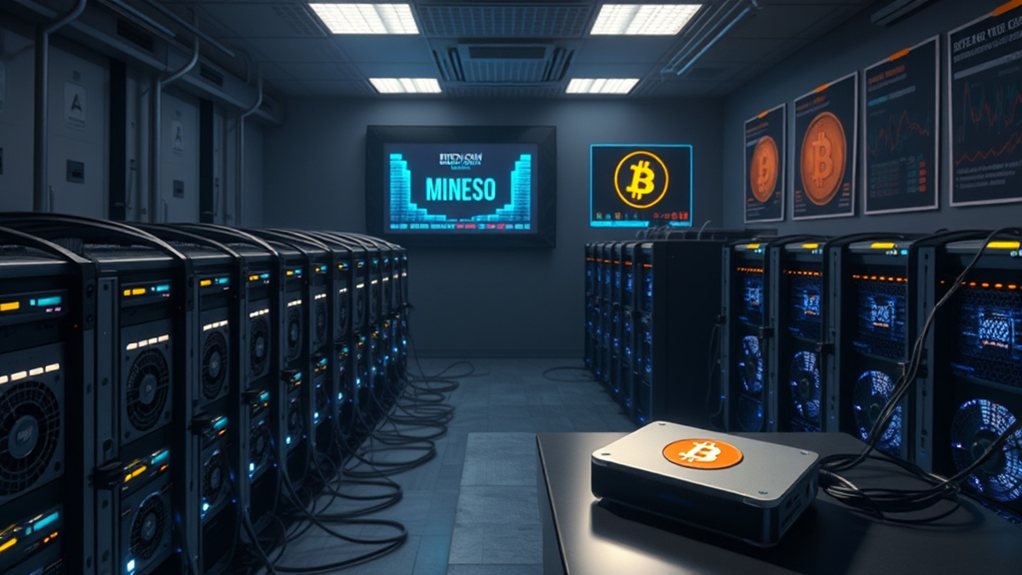Bitcoin mining requires specialized ASIC mining hardware, reliable internet, and electricity. Miners validate transactions and add new blocks to the blockchain through a competitive process of solving complex puzzles. They can mine solo or join mining pools to combine resources for better chances of earning rewards. Profitability depends on Bitcoin's price, electricity costs, and mining difficulty. The complete process involves several technical considerations for success.

Diving into the world of Bitcoin mining requires understanding a few key concepts. Bitcoin mining is the process of validating transactions and adding them to the blockchain. Miners solve complex mathematical problems using a proof-of-work system. They compete with each other to solve puzzles and earn rewards. When successful, a new block is added to the blockchain about every 10 minutes.
Today's Bitcoin miners use specialized equipment called ASIC miners. These devices are designed specifically for mining Bitcoin. High-end graphics cards (GPUs) aren't efficient for Bitcoin mining anymore. Miners also need powerful cooling systems to prevent their equipment from overheating. A reliable internet connection and adequate power supply are vital for continuous mining operations. Mining Bitcoin requires ASIC hardware for substantially higher efficiency compared to GPU-based setups.
Several software options help miners connect their hardware to the Bitcoin network. Popular programs include CGMiner, BFGMiner, and EasyMiner. Miners need a secure Bitcoin wallet to store their earned rewards. They must also verify their operating system is compatible with their chosen mining software. The software helps synchronize with the blockchain to verify transactions. This validation process is essential for network security and maintaining the decentralized nature of the blockchain.
Miners can work alone or join forces with others. Solo mining means one person uses their equipment to mine independently. They get the full reward if successful, but chances of solving a block are low. Mining pools combine resources of multiple miners to increase chances of success. Popular pools include Slush Pool, F2Pool, and Antpool. These pools typically charge fees between 1% and 3% of earnings.
The energy consumption of Bitcoin mining is substantial. The network uses between 91 and 150 terawatt-hours annually. Electricity costs greatly impact a miner's profits. The Cambridge Bitcoin Electricity Consumption Index estimates that mining operations consume approximately 0.44% of global demand. Many miners now use renewable energy sources to reduce expenses. Energy-efficient equipment also helps lower operational costs. Electricity rates vary by location, affecting overall mining expenses.
Several factors determine if mining will be profitable. Bitcoin's price changes constantly, affecting potential earnings. The network difficulty increases as more miners join, making it harder to earn rewards. Every four years, a "halving" event cuts the block reward in half. As of 2025, miners receive 6.25 Bitcoin per block. Return on investment depends on equipment costs and ongoing expenses.
Mining regulations differ around the world. Some countries welcome mining operations, while others restrict or ban them entirely. Miners often face tax obligations on their earnings in many jurisdictions. Environmental concerns have led to increased scrutiny of mining operations. It's important for miners to comply with local laws and regulations wherever they operate.
Frequently Asked Questions
What Environmental Impact Does Bitcoin Mining Have?
Bitcoin mining has significant environmental impacts. It consumes as much electricity as Argentina, representing 0.5% of global usage.
The process emits 65-85 megatons of CO2 annually, similar to Greece's emissions. It's also responsible for substantial water usage, land consumption, and electronic waste.
While some miners are shifting to renewable energy, critics argue that proof-of-stake alternatives could reduce energy use by over 99%.
Can I Mine Bitcoin on My Smartphone?
Mining Bitcoin on smartphones is technically possible but highly impractical.
Phones lack the specialized hardware needed for efficient mining. The process drains batteries quickly, causes devices to overheat, and yields virtually no profit.
Most mobile mining apps generate mere fractions of pennies while potentially damaging the phone.
Security experts warn that many smartphone mining applications are malicious, designed to steal data rather than help users earn cryptocurrency.
Is Bitcoin Mining Legal in All Countries?
Bitcoin mining isn't legal in all countries. China, Egypt, Algeria, and Nepal have banned it completely.
Kosovo temporarily halted mining in 2022 due to energy concerns. Many nations have restrictions rather than outright bans.
The legality often depends on local energy policies and financial regulations. Countries that permit mining are increasingly watching operations closely, with growing attention to energy usage and tax implications.
How Much Electricity Does Bitcoin Mining Actually Consume?
Bitcoin mining consumes between 91 and 150 terawatt-hours of electricity annually.
That's about 0.5-0.6% of global electricity use, similar to what entire countries like Argentina or the Netherlands consume.
A single Bitcoin transaction uses roughly 1,200-1,319 kilowatt-hours on average.
While over 50% of mining now uses renewable energy, the industry's power consumption remains a concern for many governments and environmentalists.
Will Quantum Computing Make Current Mining Equipment Obsolete?
Quantum computing might eventually make current mining equipment obsolete, but not anytime soon.
Experts predict it could take 15-30 years before quantum computers pose a real threat to cryptocurrency systems. While these advanced computers could theoretically solve mining puzzles much faster than today's equipment, they're still experimental, error-prone, and not powerful enough for practical mining applications.
The industry has time to develop quantum-resistant solutions.










